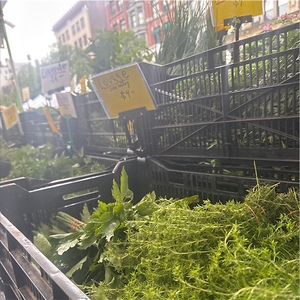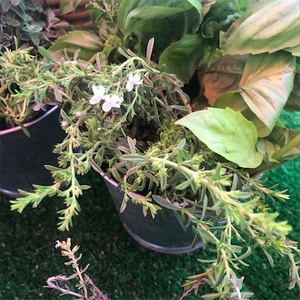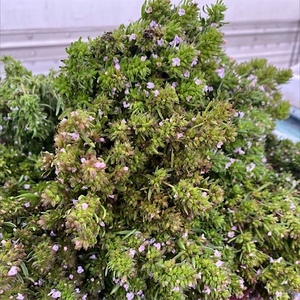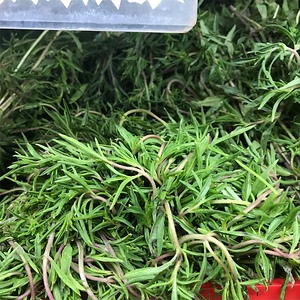


Savory
Estimated Inventory, lb : 0
This item was last sold on : 02/06/25
Description/Taste
Savory is a compact shrublike herb with woody branches, similar in structure to rosemary, that grows between 15 to 45 centimeters tall and spreads just as wide. It has square stems, characteristic of its plant family, and produces whorls of tiny white to light pink or lilac flowers when mature. The gray-green, narrow, lanceolate leaves offer a warm, sweet, peppery flavor and aroma similar to a blend of thyme, mint, and marjoram. The two primary varieties, Summer and Winter Savory, are similar in appearance and flavor, though Winter Savory is somewhat smaller with darker leaves and offers a more robust and earthy flavor and aroma with additional tones of pine and sage.
Seasons/Availability
Savory is available year-round.
Current Facts
There are about 30 species of Savory in the genus Satureja of the Lamiaceae or mint family, but the two most common species used for culinary purposes are Summer savory, botanically named Satureja hortensis, and Winter Savory, Satureja montana. As their common names imply, one of the main differences between the two is their favorite growing time of year. While Savory has earned several monikers, it is most often nicknamed the "bean herb" or "bohenkraut" in German, thanks to its traditional pairing in various bean dishes and its anti-flatulence benefits. Winter Savory may also be called Mountain Savory, a reflection of its botanical name and reference to its natural habitat.
Nutritional Value
Savory is a good source of potassium, iron, and vitamins A, C, and various B-complex vitamins, including niacin and thiamin. The essential oils in the leaves contain thymol and carvacrol, which offer natural antibacterial, expectorant, astringent, and antiseptic qualities. Savory has historically been used as an herbal remedy to ease sore throats and coughs, treat bacterial infections, reduce itching and swelling caused by insect bites, and alleviate cramping, bloating, indigestion, or stomach upset.
Applications
Savory is a salty, spicy herb used fresh or dried in both raw and cooked applications. It is often combined with other herbs in seasoning blends and is a key ingredient in the French blend, Herbs de Provence, alongside marjoram, rosemary, thyme, and oregano. The more delicate flavor of Summer Savory is often preferred for fresh use in salads with tender greens or even in cocktails like a Bloody Mary. Use fresh Summer Savory leaves to infuse white-wine vinegar for a flavorful condiment with a long shelf life that can spice up salads, sauces, soups, and roasted vegetables. Winter Savory is best for slow-cooked dishes like soups, stews, or stuffing, as it retains its flavor with long cooking times like other herbs. Rub Winter Savory into portabella mushrooms or meats like pork, beef, and chicken to impart its peppery-pine flavors before roasting or grilling, or add to bean or lentil dishes to impart saltiness without salt. Savory pairs well with other Mediterranean herbs as well as garlic, beans, lentils, rutabagas, peas, asparagus, parsnips, Brussel sprouts, eggplants, tomatoes, potatoes, eggs, seafood, lamb, beef, poultry, and fresh cheeses like sheep or goat cheese. Store fresh Savory leaves in the fridge for up to a week, wrapped in damp paper towels or sealed in a bag. Dried Savory leaves can be stored in an airtight container for up to a year.
Ethnic/Cultural Info
The ancient Romans used savory, similar to how we use pepper today, and as a salt substitute to flavor food. Savory held powerful symbolic meaning outside the kitchen in ancient Rome, known as the "herb of love." Ancient Romans believed this aromatic herb was a natural aphrodisiac and used it to make love potions. In fact, its reputation was so pervasive that European monasteries banned the growth of Savory for fear that the monks would fall under its spell at the scent of its pungent aroma. Pliny the Elder, an Ancient Roman natural philosopher and historian, bestowed the herb with the name "Satureja," believed to be derived from a hedonistic half-man, half-goat forest deity in Greek and Roman mythology known as satyr. According to folklore, satyrs roamed woodlands laden with Savory and were often depicted wearing garland crowns of the herb.
Geography/History
Savory is native to Southern Europe, the Mediterranean, Northern Africa, and Southwest Asia. The ancient Romans introduced the herb to England and other parts of northern Europe, where it was a popular herb and one of the only seasonings available until the introduction of black pepper from the spice routes out of Asia. Colonials brought Savory to the New World during the 18th century, and it is naturalized in regions throughout North America. Summer Savory is an annual plant that cannot survive winter and must be replanted each spring, while Winter Savory is a hardy perennial. Both Savory herbs are relatively low maintenance and can easily be grown in home gardens or containers or found at local farmer's markets and specialty stores.
Recipe Ideas
Recipes that include Savory. One











